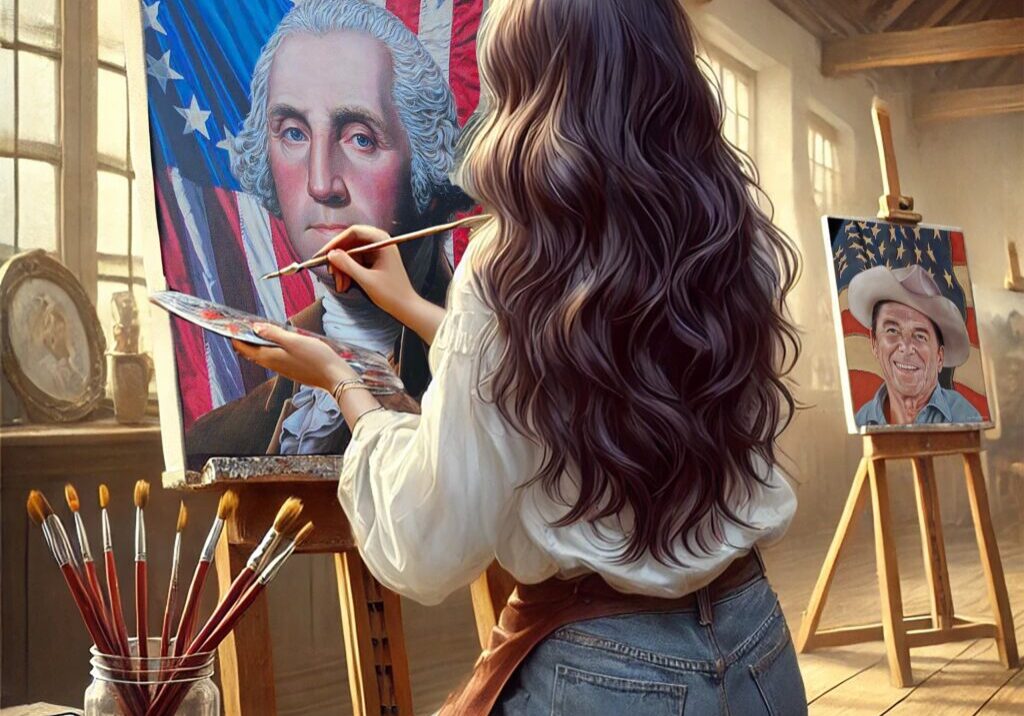
A Brush With Liberty: Charles Willson Peale’s Revolutionary Family Gallery
Charles Willson Peale didn’t just paint the American Revolution – he lived it. He fought in it. He raised a family inside it. And, through his portraits, he invited the public to walk beside it. In preparing the mural, I revisited Peale’s work more than once, not for style alone but for structure – how he organized likeness into lineage. He was painting a republic into existence, one shoulder sash, brow crease, and patriotic ribbon at a time. Peale is perhaps best known for his gallery of Revolutionary heroes, a collection that eventually grew to include over 250 portraits. Washington. Jefferson. Franklin. Hamilton. But Peale’s genius wasn’t just in capturing their faces – it was in grouping them. His museum, opened in Philadelphia, was the first American institution where the public could view portraits of the new nation’s leaders as a unified whole. That idea – putting faces to principles – is something I carry into every brushstroke of the mural. His famous 1787 The Artist in His Museum is more than a self-portrait. It’s a mission statement. Peale stands at the center, pulling back a crimson curtain to reveal a world of natural history and patriotic portraiture. It’s theatrical and humble at the same time. As an artist, I admire the dual roles he claimed – curator and creator. In many ways, our mural borrows that same approach: we’re not just painting history, we’re arranging it, placing ideas in dialogue across time. Peale’s portraits are warm, direct, and often softened by affection. His rendering of George Washington is more accessible than Stuart’s; his Lafayette sparkles with youth and optimism. These aren’t distant demigods. They’re men caught between duty and hope. Peale’s brushwork is cleaner, more frontal than Copley’s, and his use of color favors clarity over complexity. He wasn’t aiming for courtly grandeur – he was building a visual democracy. What fascinates me most, though, is how Peale painted his family into the project. His children were named after Enlightenment thinkers – Raphaelle, Rembrandt, Rubens – and many of them became artists themselves. Several even appear in the background of his larger works, assistants and inheritors of the patriotic brush. That generational theme – legacy through line – resonated deeply as I painted multigenerational figures into the mural. The Revolution wasn’t just fought in uniform. It was carried forward in art, ink, and memory. Peale’s museum was a marvel. Portraits hung beside taxidermy, inventions, fossils, and flags. It was messy, brilliant, and distinctly American. His idea was that the citizen should learn by seeing. By standing eye to eye with history. That same impulse lives in this mural: we bring the viewer face to face with the people who shaped the nation – not just the generals and presidents, but the protestors, artisans, and overlooked observers. In my mural scenes, there’s often a compositional echo of Peale’s arrangement. Figures are grouped with symbolic purpose. A child points upward not just for drama, but to direct the eye to a fluttering parchment. A gaze from one figure leads you across the canvas to another’s hand. These aren’t static groupings. They are interconnected lives. And Peale’s family gallery taught me how to let those stories overlap without chaos. Peale painted in a time of uncertainty, but with remarkable visual confidence. His subjects emerge clearly from their backgrounds, light cast purposefully, often with a symbolic object – a scroll, a sword, a book. He trusted the viewer to read the signs. And he trusted his nation to see itself in its portraits. As I painted the mural, I carried that trust with me. Not every figure is named. Not every gesture is explained. But the echoes are there. From Peale’s soft hands and tilted heads to the way his children stood quietly in the wings, waiting to take the brush. A nation needs painters to remember what it stood for – and to remind it what still matters.

